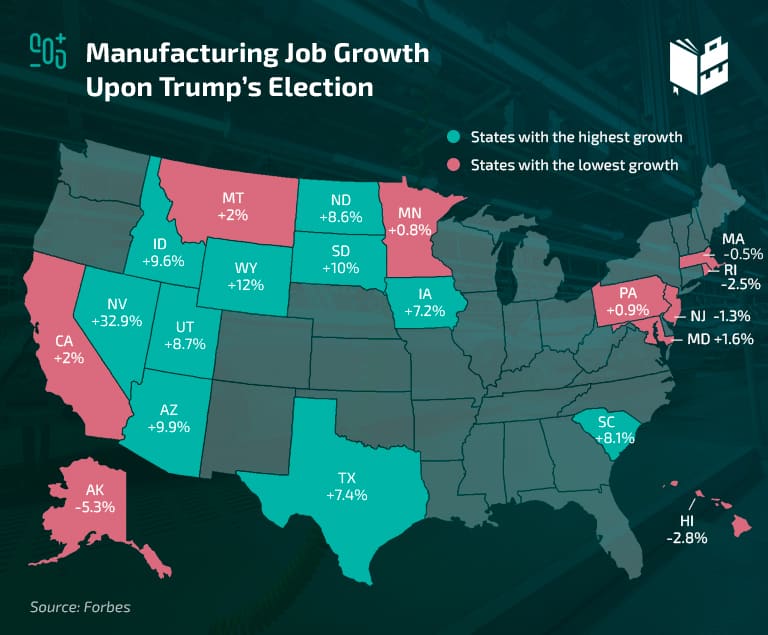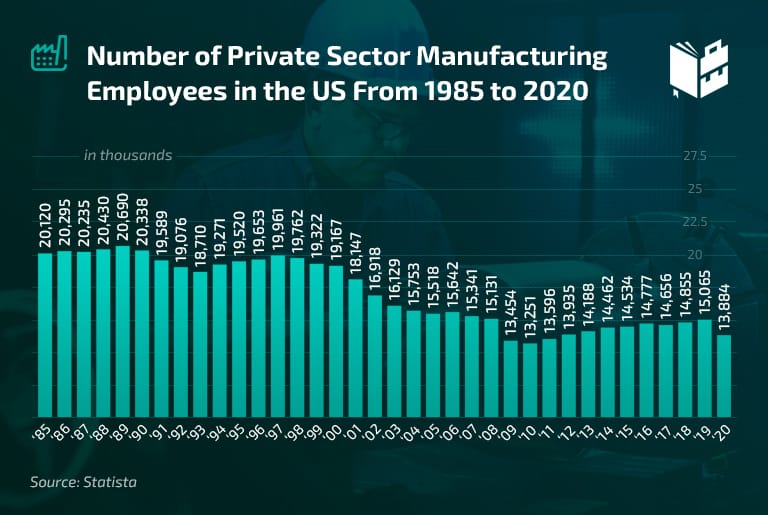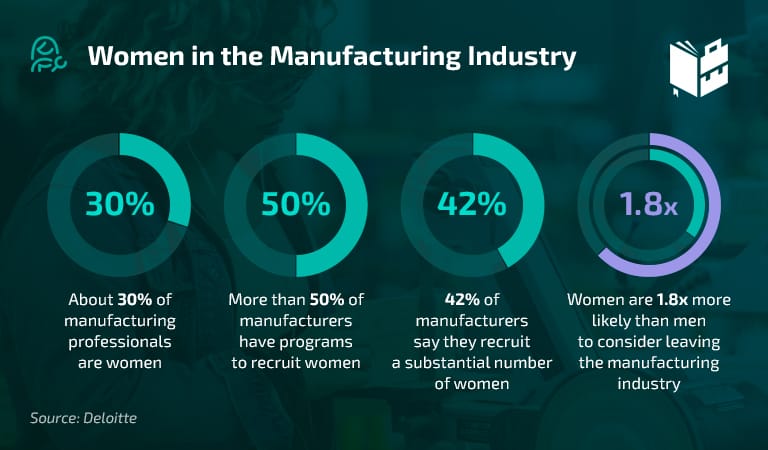With the world’s population growing, the output of the manufactured material has never been higher. Paradoxically, the loss of manufacturing jobs is more significant than ever. Currently, fewer than one in ten workers are employed in the manufacturing industry.
The COVID-19 spread and the containment measures additionally worsened the negative trend. If you want to find out more, the data below speaks about the impact of the pandemic on the jobs in the manufacturing industry. Moreover, you’ll learn about the employment trends in the industry over the years.
The final part of the article contains manufacturing job projections. But first, there’s a list of highlights, touching on all the information in the article.
Key Manufacturing Job Loss Statistics (Editor’s Choice)
- 11.39% of the total US output comes from manufacturing.
- 19.5 million people were employed in the manufacturing industry in 1979.
- 50 years ago, the manufacturing sector employed 36% of all male workers.
- The industry added only 61,000 jobs in 2019.
- Automation has caused the loss of over 7.2 million manufacturing jobs.
- Due to the coronavirus outbreak, the industry lost 1.33 million jobs.
- Projections are that the manufacturing industry will lose 444,800 jobs by 2029.
- In the next decade, four million jobs will open in the manufacturing sector.
US Manufacturing Statistics — The Latest Facts and Figures
1. The latest data shows that manufacturing accounts for 11.39% of the total US output.
(NAM, Salary)
The manufacturing industry employs 8.51% of the total US workforce. As of 2021, 12.29 million employees across manufacturing sectors take annual compensation ranging from $33,249 to $279,488.
2. Trump added 499,000 manufacturing jobs in the first 30 months of his term.
(Forbes)
When you break down manufacturing jobs by year, it’s clear that the gains during Trump’s 30 months are on par with the gains between 2010 and 2019, when 166,000 jobs were added per year. In comparison, President Obama added only 185,000 jobs during the first 30 months of his term.
3. Upon Trump’s election, Nevada added 32.9% more manufacturing jobs.
(Forbes)
On the other hand, manufacturing jobs statistics show that California has the highest marginal income tax rate of 13.3%. Moreover, the state has the highest business taxes and had only 2% payroll growth during the said period.

4. With 5.3%, Alaska is on the top of the list of the states with the highest manufacturing job loss rate.
(Forbes)
Looking closer at manufacturing job losses by state, we learned that Alaska (-5.3%) and Hawaii (-2.8%) are topping the list. Furthermore, Rhode Island has seen a decline of 2.5%, followed by New York (-1.3%) and Massachusetts (-0.5%). With 0.8%, Minnesota has a sluggish growth in manufacturing jobs, similar to Pennsylvania with 0.9%. Maryland (1.6%), California (2%), and Montana (2%) also have a slow job growth rate.
Loss of US Manufacturing Jobs over the Years
5. In 1979, 19.5 million people were working in manufacturing.
(CNS News, NAM)
The peak of the American working class was in the late 1970s. From that moment on, the number of employees in the sector has declined to around 37%. Today, there are about 12.8 million manufacturing workers in the US. Moreover, the rate of people getting a higher education is one of the factors that led to the decline of American manufacturing employment.
6. In 1989, 20.06 million people were employed in the private manufacturing sector.
(Statista)
This is the highest number of US manufacturing jobs by year recorded between 1985 and 2020. Conversely, the sharpest decline in jobs happened between 1997 and 2011 when the number of manufacturing employees in the private sector fell from 19.9 to 13.2 million.

7. 50 years ago, the manufacturing industry employed 36% of male workers.
(Urban)
Given the prosperity of the 1950s and 1960s, the explosive growth of the middle class after World War II is closely related to the high salaries of male manufacturing workers. Since then, the US has seen a vast number of manufacturing jobs lost. Today, only 15% of male workers are employed in the industry.
8. Each state lost between 20,000 and 40,000 manufacturing jobs in July 2020.
(POLITICO, BLS)
Many manufacturing jobs were lost in the pre-pandemic period nationwide. In fact, Michigan (-63,600), Ohio (-38,400), Indiana (-16,700), Wisconsin (-11,600), Minnesota (-15,400), and Pennsylvania (-36,600) started facing declines in manufacturing jobs in February 2019.
The trend began well before the pandemic, and the country has lost 720,000 manufacturing jobs in total since then. Nevertheless, the loss of manufacturing jobs since 1980 was highest during the first 17 years of the 21st century (7.5 million).
9. The nondurable goods manufacturing sector lost 11,000 jobs in March 2020.
(Industry Week)
In addition, 18,000 manufacturing workers lost their jobs, while the fabricated metal products sector lost 4,400 jobs.
It turns out printing and related support activities and chemicals experienced chief losses in the nondurable goods manufacturing category — minus 3,500 and 3,000 jobs, respectively.
10. Manufacturing in Wisconsin has lost around 120,000 jobs over the last 20 years.
(AAE.wisc.edu, FRED)
The manufacturing job loss statistics show that employment has declined in most sectors in Wisconsin. However, the process is somewhat slower than in the rest of the country.
For the sake of comparison, you should know that the manufacturing industry in Wisconsin had 598,000 employees in January 2000. On the other hand, the number of employees in the industry was 479,600 in January 2020.
11. In 2019, the manufacturing industry added only 61,000 jobs, a far cry compared to 2018.
(BLS, Statista)
The number of manufacturing jobs in the US decreased as employment slowed down in 2019. The employment rate was significantly lower compared to the previous year when the US gained 264,000 jobs. Still, at the end of the year, there were 15.06 million people employed in manufacturing — an improvement from 14.85 million in 2018.
Reasons for Loss of Manufacturing Jobs
12. More than 7.5 million manufacturing jobs are lost to automation.
(BLS)
Automation drove the highest decline in US manufacturing jobs. About 7.2 million jobs have already been lost to automation, making the manufacturing employment rate go down by 37%.
What is more, predictions are that 57% of manufacturing could be fully automated in the next 20–25 years. At the same time, it’s expected that the costs of automation and robots will drop by 65% by 2025. This means that the number of manufacturing jobs lost to automation will rise in the years to come.
13. Manufacturing job openings have increased by 12% since 2018 due to skills mismatch.
(Supply Chain Dive, BLS)
The gap between skilled workers and the skills employers require is a significant contributor to the decline of manufacturing jobs. For example, the skills mismatch caused the rate of job openings to double between 2001 and 2017, going from 1.8% to 3.1%.
Manufacturing employment statistics show manufacturers in the US have difficulties filling 46% of open positions due to a mismatch in skills.
14. Women are 1.8x more likely than men to consider leaving the manufacturing industry due to the lack of work-life balance.
(Deloitte)
About 30% of manufacturing professionals are women. According to the latest Deloitte study, more than 50% of manufacturers have programs to recruit women, with 42% referring to recruitment of women as substantial.

15. Approximately 2.8 million manufacturing jobs are lost to China.
(The Conversation, EPI)
The US has lost 3.7 million jobs in total to China. In addition, US companies continue to outsource their manufacturing to China because of the low minimum hourly salary and few labor laws. Outsourcing statistics show that China’s human resources outsourcing market will probably reach $8.2 billion by 2027. As a result, two-thirds of the lost jobs are in manufacturing.
In fact, these numbers account for more than half of all US manufacturing jobs lost or displaced. In essence, the US has been losing the opportunity to add manufacturing jobs because imports from China have increased drastically, while exports haven’t increased as much.
The COVID-19 Impact on the Decline in Manufacturing Jobs
17. The manufacturing industry lost 1.33 million jobs in April 2020.
(SME)
The pandemic has undone a decade-long effort to gain manufacturing jobs as the COVID-19 virus spread slammed the economy. In fact, manufacturers of durable goods lost 914,000 jobs, whereas makers of non-durable goods lost 416,000 employees.
18. The number of manufacturing jobs dropped to 11.48 million after the coronavirus outbreak.
(SME)
The broad surge of unemployment brought about significant losses in the manufacturing industry. According to loss of manufacturing jobs statistics, the number of employees in the sector fell to just above the all-time low of 11.45 million in February 2010.
19. Manufacturing has recouped about 63% of the jobs lost due to COVID-19.
(Deloitte, Eurostat)
The coronavirus spread, and the containment measures hit the manufacturing industry hard. As a result, the unemployment rate went from 3.1% in December 2019 to 5.5% in the same month of 2020, noting a 2.4% YoY increase. Although the industry has recouped almost a third of the jobs lost to COVID-19, 570,000 people haven’t got their jobs back.
20. In September 2020, the manufacturing sector added 66,000 jobs.
(Industry Week)
This is more than double the 29,000 jobs added one month before. Still, the sector remained 647,000 jobs short of where it was pre-pandemic.
Job Loss In Manufacturing Statistics — The Future Outlook
21. Estimations show that there will be 4.6 million job openings in manufacturing in the next decade.
(BLS, CNBC)
In the next decade, manufacturing will be one of the industries with many in-demand jobs. However, given the struggle employers face to find talent, it’s predicted that 2.4 million of these jobs will remain unfilled.
22. The manufacturing sector will lose 444,800 jobs by 2029.
(BLS)
In the next decade, we’ll continue witnessing a loss of manufacturing jobs in the US. Moreover, 12 out of the 20 industries projected to experience the most rapid declines in employment are in the manufacturing industry.
On the other hand, e-commerce continues to grow in popularity, and retail trade is projected to lose 368,300 jobs.
Is the Loss of Manufacturing Jobs the Industry’s End?
The Fourth Industrial Revolution is transforming the manufacturing industry at an unprecedented pace. Predictions are that the cost of automation will drop by 65% since 2025, and nearly 60% of manufacturing will be fully automated in the next 25 years.
The economy is yet to recoup from the COVID-19 crisis, but the future seems bright — there will be 2 million job openings in the sector by 2029. And if employers leverage the technology right, it can create even more jobs instead of destroying them.